Saskatchewan offers much more than what you see from the Trans-Canada Highway. This prairie province is a wonderful destination – primarily from spring to fall when temperatures are pleasant. Before you venture to the province, have a read through these irreverent but interesting facts about Saskatchewan for some perspective on the province.
My husband John penned these 47 interesting facts about Saskatchewan. As you’ll see below he has an offbeat sense of humour.
This post includes some affiliate links. If you make a qualifying purchase through one of these links, I will receive a small percentage of the sale at no extra cost to you. Thank you very much for your support.

Here goes – 47 interesting facts about Saskatchewan – many you probably don’t know.
Saskatchewan has been a land-locked Canadian prairie province since 1905.
It has the best name! It is so much fun to say; Sas-KATCH-ew-un.
Why would you call a province Saskatchewan? Well you might if you met Indigenous Cree people and they told you that there was a Kisiskatchewani Sipi. That means “big swiftly flowing river.” Much easier to say Saskatchewan than “Big Swiftly Flowing River Province.”
There are 70 First Nations in Saskatchewan with Cree, Dakota, Dene (Chipewyan), Nakota (Assniboine) and Saulteaux people. Cree is the second most spoken language in Saskatchewan with over 20,000 native speakers.
People from here are called Saskatchewanians or Saskatchewanites; not Sasquatches.
Saskatchewan borders six jurisdictions: Alberta, Northwest Territories, Nunavut, Manitoba, North Dakota and Montana. Lots of neighbours.

Interesting facts about the geography of Saskatchewan
Saskatchewan is trapezoidal in shape and is supposed to be bound on the south and north by the 49th and 60th parallels respectively. It’s also supposed to lie between the 102nd and 110th west degrees of longitude.
Supposed to, but actually doesn’t, because of some minor surveying errors on the 49th parallel and the 102nd west degree of longitude. The bugs must have been bad at the time or the surveyors were on a bender.
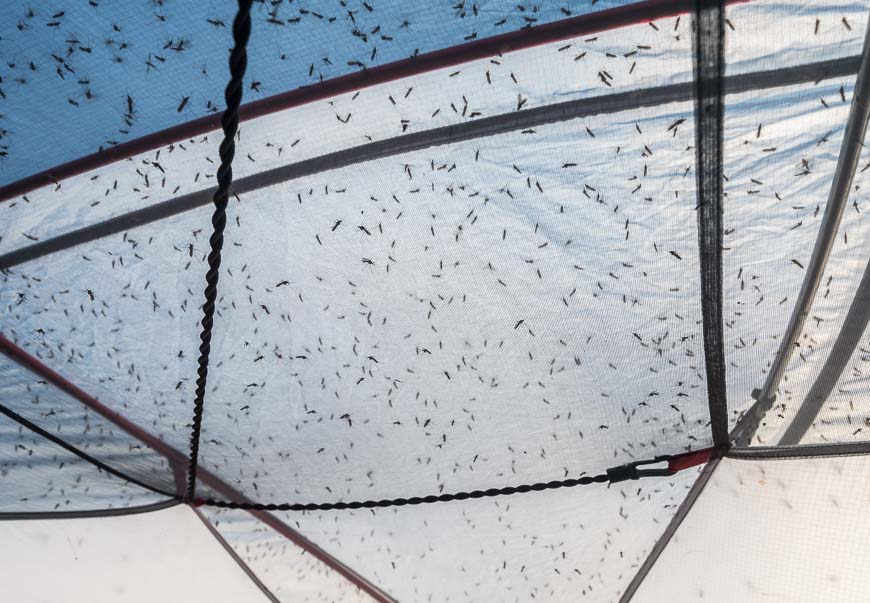
Saskatchewan is in the central time zone and does not do Daylight Saving Time.
So how big is Saskatchewan? Almost 652,000 square kilometres which alas is a bit smaller than Texas which is about 696,000 square kilometres. Damn it!
A trip straight north from the US border to the 60th parallel is 1,225 km but no road actually does that since the northern part is very wild.
The northern part of the province is underlain by Canadian Shield and has a gazillion lakes (well 100,000 or so) and the southern part is prairie, but we don’t know how many lakes are in this part. And, we are not going to count them.
According to one source, half of Saskatchewan is forest, farmland makes up a third and freshwater water covers one eighth. That adds up to 95.83% so what about the other 4.17%?
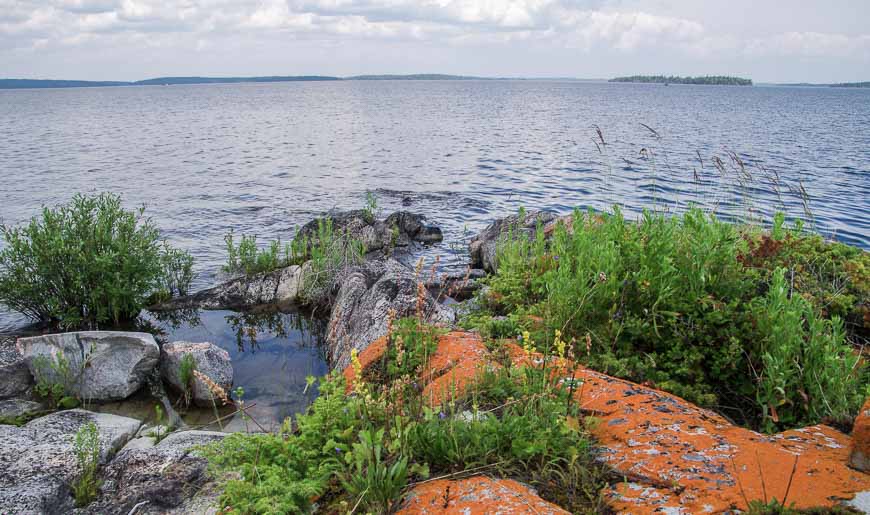
The highest point in Saskatchewan
Bet you didn’t ever wonder about what is the highest point of land between Labrador and the Rockies. It is in the Cypress Hills in SW Saskatchewan. In fact, at 1400 m it is higher than Banff and about 600 m higher than the surrounding plains.

About 1.2 million people live in Saskatchewan. They mostly live in the southern half of the province which has better farmland.

Interesting facts about weather in Saskatchewan
Saskatchewan gets a lot of sunlight and some say the most of any province. But be careful if you repeat that because it might start a fight with an Albertan. So, our official position is that Saskatchewan gets a lot of sunlight especially during the day.
Some say, especially those in Estevan, that Estevan is the sunniest place in Canada. Oh, Oh, we can see a fight coming from Medicine Hat, Swift Current, Kindersley and others but not from Prince Rupert in BC where it rains 246 days a year.
Apparently, the highest temperature ever recorded in Canada, 45°C (113°F), was in Midale.
Check out this book – 110 Nature Hot Spots in Saskatchewan: The Best Parks, Conservation Areas and Wild Places, written by two friends of mine, for inspiration on places to visit in Saskatchewan.
And apparently, someone in Prince Albert recorded −56.7 °C (−70.1 °F) as the lowest provincial temperature. A long time ago I was working in a winter tent camp in Northern Saskatchewan and it was so cold that my contact lenses froze in their case. It might have been -56.8 and that could have been the record but as noted, my contacts were frozen in the case so I couldn’t see the thermometer.
If you are into hailstones apparently one as big as a grapefruit weighing almost 300 grams fell in Cedoux in 1973. Now that would hurt. Hard to argue with this record since all the other ones have melted now.
One of the interesting facts about Saskatchewan is what their flag represents. The upper half of the flag is green which represents the northern forests and the lower half is gold in deference to the fields of grain in the south. It has other stuff too like the western red lily which is the provincial flower.
Precipitation in Saskatchewan could end up ultimately flowing to the Arctic Ocean, Hudson’s Bay or the Gulf of Mexico.

Interesting facts about Saskatchewan – their provincial icons
Speaking of Provincial stuff: Provincial Sport? Curling
Provincial animal? White -tailed deer which can weigh up to 180 kg (400 pounds) That’s a big deer!
Provincial Tree? white birch – goes with the deer’s tail.
Provincial Bird? Sharp-tailed grouse
Provincial Grass? Really! There was a debate over the provincial grass? Needle and thread grass grows 4 feet tall.
Provincial mineral? OK, a lot of places have no business picking a provincial mineral but Saskatchewan does produce a lot of potash so we accept Sylvite. And it does start with “S” so that’s good.
Interesting facts about Saskatchewan – there are enormous sand dunes
Sand dunes! How about 100 km of sand dunes, the most northerly in the world along the south shore of Lake Athabasca; the largest lake in the Province and the 8th largest in the country. And yes, you guessed it, Athabasca is an anglicized Cree expression. The original meaning was something like “reeds here and there.” Can also be used in an orchestral setting eg. “We notice Athabasca.” Not a common usage. Also, there are reportedly 10 plants that grow here in the dunes and no where else in the world. Several bonus facts here.
There are more dunes up to 25 m high in Great Sand Hills in southwest Saskatchewan.

The second largest Lake in Saskatchewan, Reindeer Lake, is also the deepest (210 m) because of a meteor impact crater in, you guessed it; Deep Bay. Actually, the meteor hit about 140 million years ago but the glacier picked out the battered rocks making a deep hole that water filled.

Saskatchewan has its own Dead Sea
We have been to the Dead Sea and one floats so high one almost didn’t get wet! OK, that’s an exaggeration but imagine floating in Little Lake Manitou east of Saskatoon which is THREE times saltier than the ocean. The indigenous people claimed that these are healing waters. It would heal sinking.
Recommended reading: 12 Fun & Unique Places to Visit in Saskatchewan
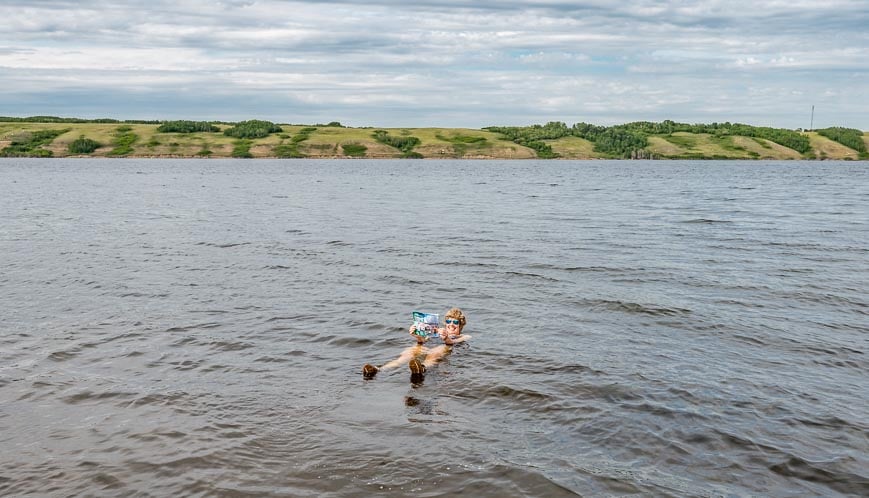
There are several lakes in the same general area including Lenore Lake, Quill Lakes and Basin and Middle Lakes which are most excellent birding areas. Apparently over 30 species of shore birds have been noted include the very rare whooping cranes.
Tyrannosaurus rex fossils were found near Eastend. Glad we didn’t visit 65 million years ago!
Speaking of a long time ago, Indigenous Peoples used sites just north of Saskatoon 6,000 years ago. This is based on evidence discovered in archaeological digs located in what is now Wanuskewin Heritage Park. These sites are noted as being older than the Egyptian pyramids (4,600 years old) which might explain why people visited Saskatoon since there wasn’t much to see in Egypt at the time.

They grow a lot of wheat, mustard and pulse crops in Saskatchewan
Saskatchewan produces over 54% of the wheat grown in Canada. No surprise here.
Surprise here though; Canada is the leading exporter of pulse crops in the world, and a lot of those come from Saskatchewan. Don’t know what a pulse is? Pulses beside being heartbeats are also peas, soybeans, chick peas, fava beans and lentils. Saskatchewan exported 67% of the world’s lentils in 2015.
Another surprise; Canada is evidently, the world’s top mustard grower and Saskatchewan grows 75 % of it.
Regina is the provincial capital and, in case you were wondering, the first instant tellers in Canada were used in Regina in 1977.
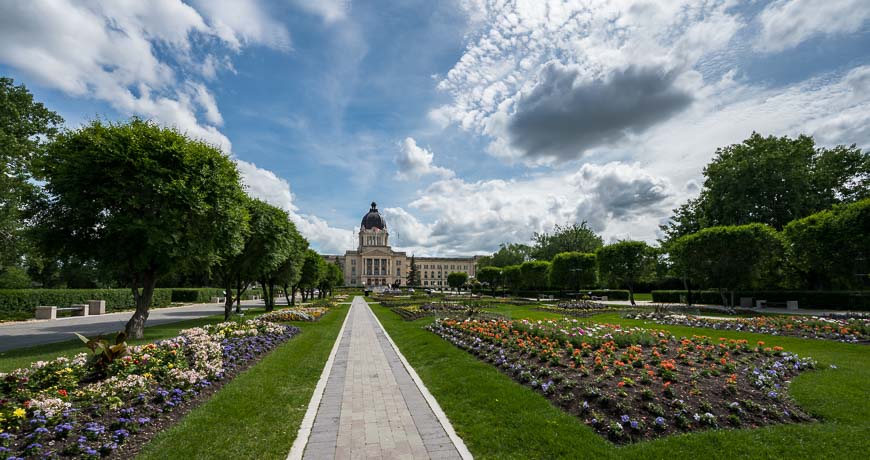
Regina is also home to Canada’s only Royal Canadian Mounted Police (RCMP) training academy.
The largest city is Saskatoon with a 2019 population of about 273,000 people. It’s a fun place with a great restaurant scene. One of the unique and interesting facts about Saskatchewan is that Saskatoon is home to Baba’s Homestyle Perogies, which is likely the only perogie drive thru in Canada.
Recommended read: 6 Fun Things to do in Saskatoon In Summer

What is Moose Jaw, Saskatchewan famous for?
Moose Jaw is not the capital or the largest city but it does have the Tunnels of Moose Jaw. They were originally built for maintenance and heating purposes but have also served well as escapeways. Most notably, Al Capone used them in the 1920s and 30s for bootlegging and a hideaway when thing in Chicago got a little testy. Organized tours are available.
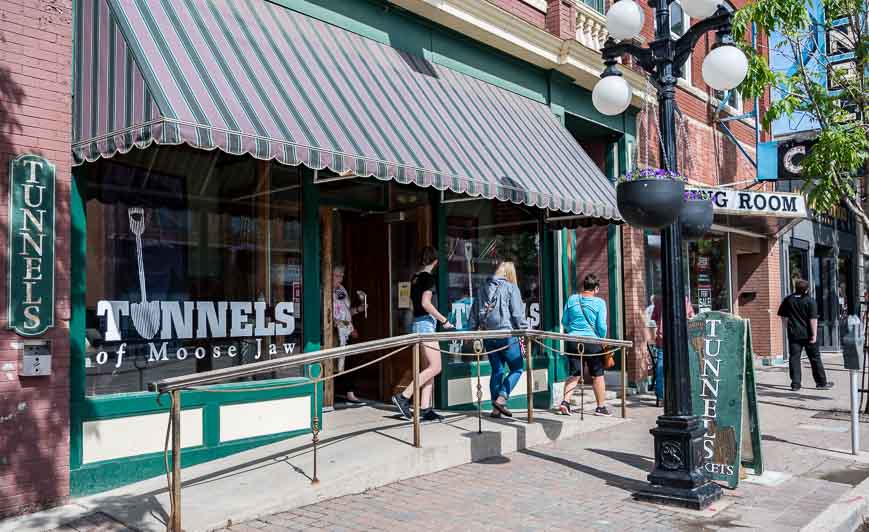
NHL Hockey players from Saskatchewan
For hockey lovers, one of the interesting facts about Saskatchewan is the fact that Saskatchewan produces the most National Hockey League players per capita of any province. There are 17 inductees into the Hall of Fame including a guy called Gordie Howe who was pretty good. Actually, he was one of the best ever!
National Parks in Saskatchewan
There are two national parks in Saskatchewan – Grasslands National Park (2 sections to it – an east block and a west block) located in the southern part of the province and Prince Albert National Park north of Saskatoon. Grasslands is famous for its dark skies and abundant wildlife.
From my experience in Prince Albert in June, the abundance wildlife including deer and an overwhelming number of biting insects. But in winter, Prince Albert National Park is incredible and there’s lots of wildlife to be seen.

The longest hiking trail in Saskatchewan
Saskatchewan is not a province that hikers tend to flock to. But one of the interesting facts about Saskatchewan is that is has one long trail – The Boreal Trail in Meadow Lake Provincial Park. It’s 120 km long and will take you through beautiful boreal forest.

Random facts about Saskatchewan
In Fort Qu’Appelle it’s reportedly illegal to walk down the main street with untied shoes.
The largest canola plant in the world is located in Maidstone, Saskatchewan
Further reading about Saskatchewan
Visit Tourism Saskatchewan for lots of additional information if you’re thinking of a visit to the province.
- A Hike on the Nut Point Trail near La Ronge
- 10 Things to do in Saskatoon in Winter
- A Hike to Grey Owl’s Cabin in Prince Albert National Park
- A Stay at Historic Reesor Ranch in Saskatchewan

Click on the photo to bookmark to your Pinterest boards.



